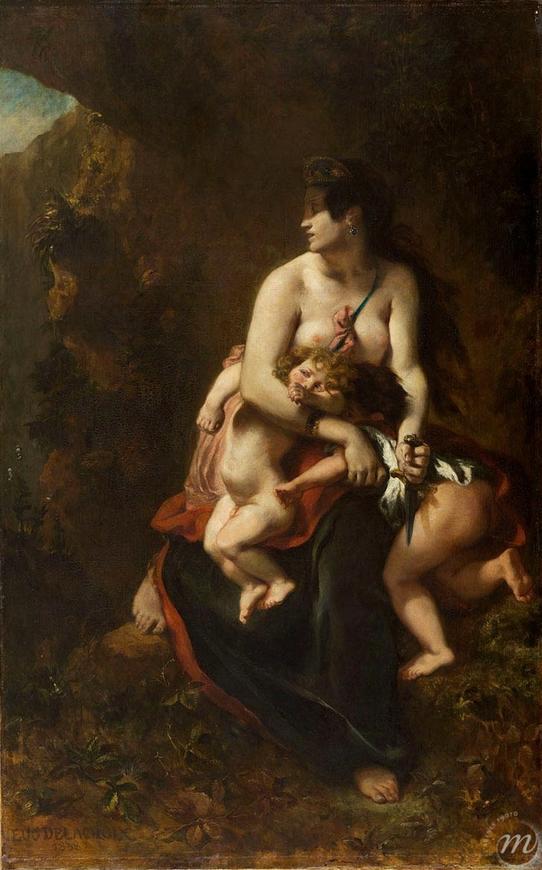Rejected by Jason, who picked the King of Corinth's daughter over her, she flies into an avenging rage and decides to cut the throats of their two sons. Delacroix chose to depict this moment of high tension that precedes the crime. The young woman knows she is being hunted and looks worried. Her posture is unstable. Her children are struggling to escape her clutches. A dark shadow partly masks her face, representing the madness that blinds her.
The composition is pyramidal. It seems simple, but is in fact the fruit of twenty years of research into the subject. The colours are dark: the red of the draped fabric matches cleverly the brown of the landscape and the muted green of Medea's dress. In the centre of the intermingled limbs and flesh, the dagger is the only vertical axis in the painting.
Highlighted by the white fabric, it seems to jump out from the painting, the better to warn the viewer of the drama that is about to unfold.
Tragic subject, spectacular composition, violently contrasting lighting, sensual tangle of bodies: the painting has all the ingredients of a romantic masterpiece.
Detail. The museum is lucky to also own the sketch and thirty-one preparatory drawings for the painting. Handled with great freedom, the oil sketch matches the completed work, although the artist decides against the blue cloak wrapped around the young woman's head, an effect borrowed from the neo-classicists.
(Ref. P 542)

Rejected by Jason, who picked the King of Corinth's daughter over her, she flies into an avenging rage and decides to cut the throats of their two sons. Delacroix chose to depict this moment of high tension that precedes the crime. The young woman knows she is being hunted and looks worried. Her posture is unstable. Her children are struggling to escape her clutches. A dark shadow partly masks her face, representing the madness that blinds her.
The composition is pyramidal. It seems simple, but is in fact the fruit of twenty years of research into the subject. The colours are dark: the red of the draped fabric matches cleverly the brown of the landscape and the muted green of Medea's dress. In the centre of the intermingled limbs and flesh, the dagger is the only vertical axis in the painting.
Highlighted by the white fabric, it seems to jump out from the painting, the better to warn the viewer of the drama that is about to unfold.
Tragic subject, spectacular composition, violently contrasting lighting, sensual tangle of bodies: the painting has all the ingredients of a romantic masterpiece.
Detail. The museum is lucky to also own the sketch and thirty-one preparatory drawings for the painting. Handled with great freedom, the oil sketch matches the completed work, although the artist decides against the blue cloak wrapped around the young woman's head, an effect borrowed from the neo-classicists.
(Ref. P 542)